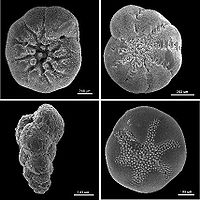- δ18O
-
 Climate record of Lisiecki and Raymo (2005) constructed by combining measurements from 57 globally distributed deep sea sediment cores. The measured quantity is oxygen isotope fractionation (δ18O) in benthic foraminifera.[1]
Climate record of Lisiecki and Raymo (2005) constructed by combining measurements from 57 globally distributed deep sea sediment cores. The measured quantity is oxygen isotope fractionation (δ18O) in benthic foraminifera.[1]
In geochemistry, paleoclimatology and paleoceanography δ18O or delta-O-18 is a measure of the ratio of stable isotopes 18O:16O. It is commonly used as a measure of the temperature of precipitation, as a measure of groundwater/mineral interactions, as an indicator of processes that show isotopic fractionation, like methanogenesis. In paleosciences, 18O:16O data from foraminifera and ice core are used as a proxy for temperature. The definition is, in "per mil" (‰, parts per thousand):
where the standard has a known isotopic composition, such as Vienna Standard Mean Ocean Water (VSMOW).[2] The fractionation can arise from kinetic, equilibrium, or mass-independent fractionation.
Contents
Mechanism
Foraminifera shells of calcium carbonate (CaCO3), having oxygen in them, and being found in many common geological features, are most commonly tested. The ratio of 18O to 16O is used to tell the temperature of the surrounding water of the time solidified, indirectly. The ratio varies slightly depending on the temperature of the surrounding water, as well as other factors such as the water's salinity, and the volume of water locked up in ice sheets.
δ18O also reflects local evaporation and freshwater input, as rainwater is 16O enriched—a result of 16O's preferential evaporation from seawater. Consequently, the surface ocean contains greater amounts of 18O around the subtropics and tropics where there is more evaporation, and lesser amounts of 18O in the mid-latitudes where it rains more.
Similarly, when water vapor condenses, heavier water molecules holding 18O atoms tend to condense and precipitate first. The water vapor gradient heading from the tropics to the poles gradually becomes more and more depleted of 18O. Snow falling in Canada has much less H218O than rain in Florida; similarly, snow falling in the center of ice sheets has a lighter δ18O signature than that at its margins, since heavier 18O precipitates first.
Changes in climate that alter global patterns of evaporation and precipitation therefore change the background δ18O ratio.
Calculations
If the signal can be attributed to temperature change alone, with the effects of salinity and ice volume change ignored, a δ18O increase of 0.22‰ is equivalent to a 1 °C (1.8 °F) cooling.[3] Temperature can also be calculated using the equation:
During the pleistocene, a 0.11‰ δ18O signature correlates to 10 m of sea level change as a consequence of changing ice volume.
See also
References
- ^ Lisiecki, L. E.; Raymo, M. E. (January 2005). "A Pliocene-Pleistocene stack of 57 globally distributed benthic δ18O records" (PDF). Paleoceanography 20: PA1003. Bibcode 2005PalOc..20.1003L. doi:10.1029/2004PA001071. http://lorraine-lisiecki.com/LisieckiRaymo2005.pdf.
Lisiecki, L. E.; Raymo, M. E. (May 2005). "Correction to “A Pliocene-Pleistocene stack of 57 globally distributed benthic δ18O records”". Paleoceanography 20: PA2007. Bibcode 2005PalOc..20.2007L. doi:10.1029/2005PA001164.
data: doi:10.1594/PANGAEA.704257. - ^ "USGS -- Isotope Tracers -- Resources -- Isotope Geochemistry". http://wwwrcamnl.wr.usgs.gov/isoig/res/funda.html. Retrieved 2009-01-18.
- ^ Visser, K.; Thunell, Robert; Stott, Lowell (2003). "Magnitude and timing of temperature change in the Indo-Pacific warm pool during deglaciation". Nature 421 (6919): 152. doi:10.1038/nature01297.
- Clark, I.D. and Fritz, P (1997). Environmental Isotopes in Hydrogeology. CRC Press. ISBN 1566702496.
- Schmidt, G.A. (1999). "Forward Modeling of Carbonate Proxy Data from Planktonic Foraminifera Using Oxygen Isotope Tracers in a Global Ocean Model". Paleoceanography 14 (4): 482–497. Bibcode 1999PalOc..14..482S. doi:10.1029/1999PA900025. http://www.agu.org/pubs/crossref/1999/1999PA900025.shtml.
Categories:
Wikimedia Foundation. 2010.




